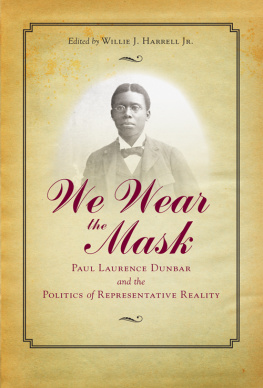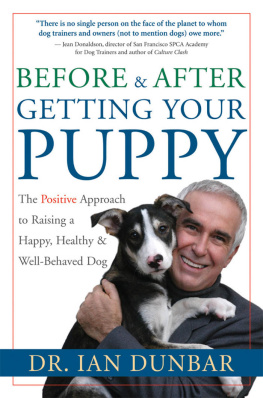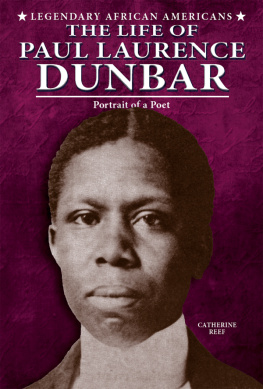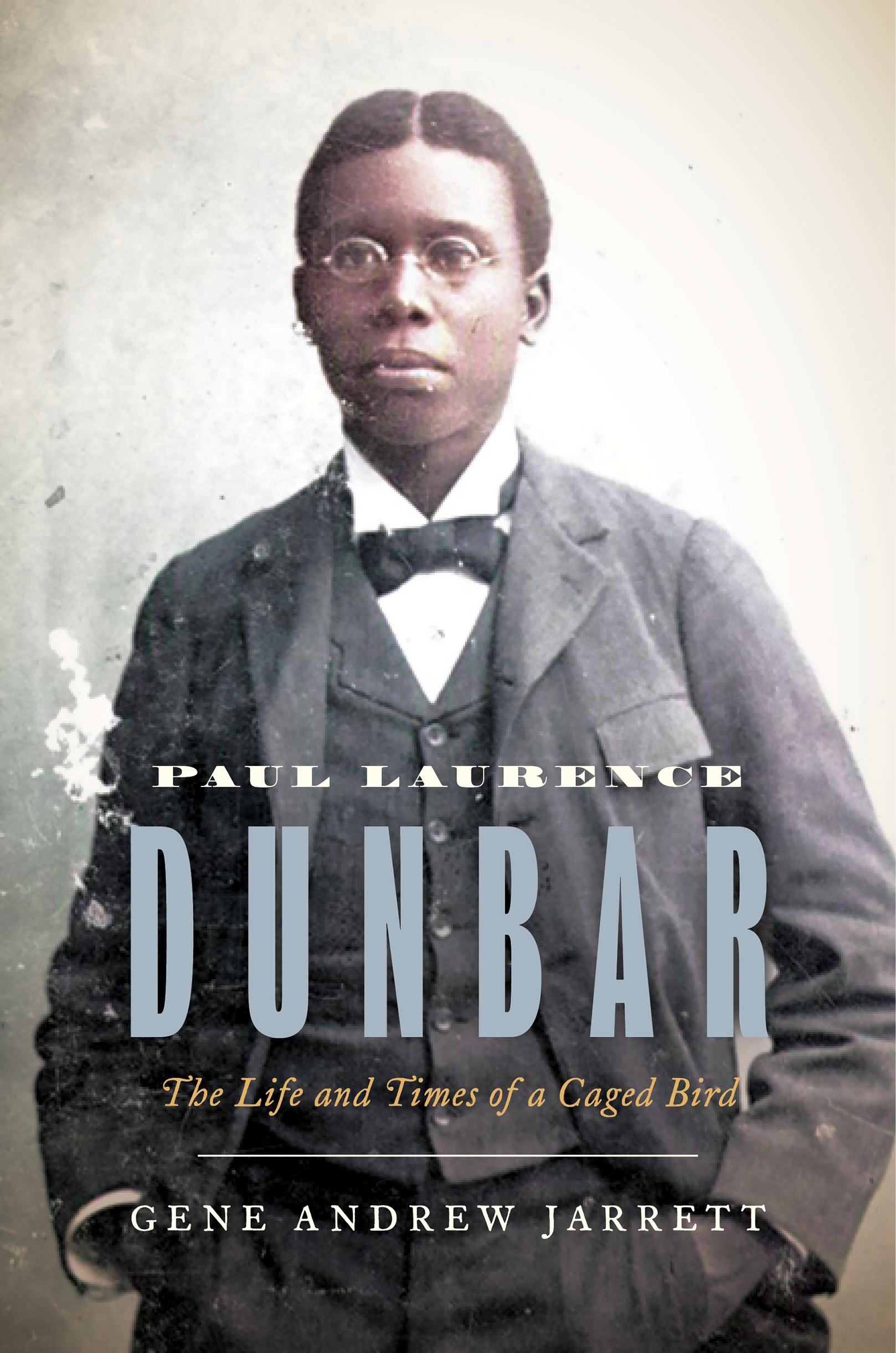PAUL LAURENCE DUNBAR
PAUL LAURENCE
DUNBAR
The Life and Times of a Caged Bird
GENE ANDREW JARRETT
PRINCETON UNIVERSITY PRESS
PRINCETON AND OXFORD
Copyright 2022 by Gene Andrew Jarrett
Princeton University Press is committed to the protection of copyright and the intellectual property our authors entrust to us. Copyright promotes the progress and integrity of knowledge. Thank you for supporting free speech and the global exchange of ideas by purchasing an authorized edition of this book. If you wish to reproduce or distribute any part of it in any form, please obtain permission.
Requests for permission to reproduce material from this work should be sent to
Published by Princeton University Press
41 William Street, Princeton, New Jersey 08540
99 Banbury Road, Oxford OX2 6JX
press.princeton.edu
All Rights Reserved
Library of Congress Cataloging-in-Publication Data
Names: Jarrett, Gene Andrew, 1975 author.
Title: Paul Laurence Dunbar: the life and times of a caged bird / Gene Andrew Jarrett.
Description: Princeton: Princeton University Press, 2022 | Includes bibliographical references and index.
Identifiers: LCCN 2021033992 (print) | LCCN 2021033993 (ebook) | ISBN 9780691150529 (hardback; acid-free paper) | ISBN 9780691235158 (ebook)
Subjects: LCSH: Dunbar, Paul Laurence, 18721906. | Poets, American19th centuryBiography. | African American poetsBiography. | LCGFT: Biographies.
Classification: LCC PS1557.J37 2022 (print) | LCC PS1557 (ebook) | DDC 811/.4 [B]dc23
LC record available at https://lccn.loc.gov/2021033992
LC ebook record available at https://lccn.loc.gov/2021033993
Version 1.0
British Library Cataloging-in-Publication Data is available
Editorial: Anne Savarese and James Collier
Production Editorial: Ellen Foos
Text Design: Karl Spurzem
Jacket Design: Lauren Michelle Smith
Production: Erin Suydam
Publicity: Jodi Price and Carmen Jimenez
Copyeditor: Daniel Simon
Jacket image: Paul Laurence Dunbar at age 19. Paul Laurence Dunbar Collection / Ohio History Connection
For the Boynton-Jarrett Family
and
in memory of
Toni Morrison
(19312019)

FIG. 0.0. Paul Laurence Dunbar, circa 1890. (Paul Laurence Dunbar Small Picture Collection, Ohio History Connection)
I know what the caged bird feels, alas!
When the sun is bright on the upland slopes;
When the wind stirs soft through the springing grass,
And the river flows like a stream of glass;
When the first bird sings and the first bud opes,
And the faint perfume from its chalice steals
I know what the caged bird feels!
I know why the caged bird beats his wing
Till its blood is red on the cruel bars;
For he must fly back to his perch and cling
When he fain would be on the bough a-swing;
And a pain still throbs in the old, old scars
And they pulse again with a keener sting
I know why he beats his wing!
I know why the caged bird sings, ah me,
When his wing is bruised and his bosom sore,
When he beats his bars and he would be free;
It is not a carol of joy or glee,
But a prayer that he sends from his hearts deep core,
But a plea, that upward to Heaven he flings
I know why the caged bird sings!
PAUL LAURENCE DUNBAR, SYMPATHY, LYRICS OF THE HEARTHSIDE (1899)
CONTENTS
- xi
ILLUSTRATIONS
Paul Laurence Dunbar, circa 1890.
Matilda Dunbar, circa 1890.
Fugitive slave paths through Kentucky and beyond.
Routes of fugitive escape on the Underground Railroad, 1860.
Conservatory and garden of Daytons Central Branch, circa 1876.
Belva Ann Lockwood.
Central High School, Dayton, Ohio, 18571893.
Paul and his Central High School classmates, with Orville Wright in back row, center, circa 1890.
Orville and Wilbur Wright, circa 18971899.
Paul and classmates in Philomathean Society, Central High School, 1890.
First issue of the Dayton Tattler (December 13, 1890).
Dayton Central High School commencement program, June 16, 1891.
James Whitcomb Riley, circa 1898.
Paul Laurence Dunbar, circa 1892.
Exposition grounds, Worlds Columbian Exposition in Chicago, 1893.
Frederick Douglass, 1893.
Will Marion Cook, n.d.
Alice Ruth Moore, circa 1895.
Dr. Henry A. Tobey, n.d.
Front page of Harpers Weekly, June 27, 1896.
William Dean Howells, circa 1900.
Frontispiece of Majors and Minors (1895).
Paul with Brand Whitlock, mayor of Toledo, Ohio, outside the home of Major James Pond, Pauls literary agent, 1896.
Samuel Coleridge-Taylor, circa 1905.
Frontispiece of Lyrics of Lowly Life (1898).
Paul with friends in England, 1897.
Paul at Berean Baptist Church, Washington, D.C., November 14, 1897.
Booker T. Washington, circa 1895.
Advertisement of Clorindy in Harpers Weekly (1898).
Charles Waddell Chesnutt, n.d.
Thomas Jefferson Building of the Library of Congress, Washington, D.C., circa 1897.
Sample decorated page and photograph from The Deserted Plantation, in Poems of Cabin and Field (1899).
Theodore Roosevelt, circa 1906.
James Weldon Johnson, circa 1900.
Paul with his mother, Matilda, circa 1896.
Paul and Alice Dunbar en route to Colorado, 1899.
Paul Laurence Dunbar on horseback, circa 1900.
Paul and friends with his mother, Matilda (back row), n.d.
Paul with a friend outside of Dayton home, circa 1905.
Bert Williams and George Walker, In Dahomey, with words by Paul Laurence Dunbar and music by Will Marion Cook (1902).
Home of Paul Laurence Dunbar, 219 North Summit Street, Dayton, Ohio, circa 1900.
Advertisement for Pauls recital with Joseph Douglass, Atlantic City, New Jersey, 1901.
Paul giving a recital at the National Cash Register Company, Dayton, Ohio, January 6, 1903.
PAUL LAURENCE DUNBAR
Introduction
In the October 1914 issue of the A.M.E. Review, an author named Alice M. Dunbar (18751935) published The Poet and His Song, reflecting on the life and character of her former husband, the legendary African American poet Paul Laurence Dunbar (18721906). In print and in person, turbulence described the six years and nine months of their relationship: infatuation and love, admiration and encouragement, but also suspicion and frustration, exasperation and fury, as well as intimidation and violence.
Even though Alice published The Poet and His Song almost nine years after Pauls death, she retained the surname Dunbar.
In lyrical prose, Alice describes the poems Paul wrote that best mirrored his unique literary sensibility.
Alice could very well have been overstating the misery surrounding the nature of Pauls job in the Library of Congress. Others who witnessed him there tell a different story, suggesting that the Library of Congress, for all its faults as an oppressive work environment, could never truly suppress Pauls brilliant sense of not only literary time and place but also how distinctive forms of art, such as music and poetry, could converge, stimulate his imagination, and move audiences.
Although its autobiographical basis in Pauls stint at the Library of Congress may be debatable, the poem Sympathy nonetheless testifies in profound, existential ways to the miraculous and transcendent bond between the poet and the world. The poem highlights the direct ratio of the poet to sympathyto the knowledge, as the poems speaker puts it, of three refrains: what the caged bird feels, why the caged bird beats his wing, and why the caged bird sings. Paul struggled with the belief that he lived and wrote like a bird trapped in a cage, however gilded it might have been by the acclaim of admirers. The poem would reverberate in the century after its publication, its lyrical poignancy and thematic cogency extended in Maya Angelous









